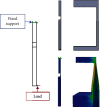Numerical Analysis of the ACL, with Sprains of Different Degrees after Trauma
- PMID: 34349834
- PMCID: PMC8328720
- DOI: 10.1155/2021/2109348
Numerical Analysis of the ACL, with Sprains of Different Degrees after Trauma
Abstract
Nowadays, cruciate ligament injuries have increased in incidence, since practicing a sport or physical activity has become a trend in current societies. Although this lifestyle generates multiple benefits, as a consequence, injury has also increased. Due to its nature and complexity, the ligaments of the knee are those that are most frequently affected, mainly the ACL (anterior cruciate ligament). This tissue reacts to overexertion or movements out of range, either caused by the exercise itself or caused by trauma caused by the practice of physical activity, causing various degrees of sprain. Whatever the etiology of these injuries, they will require a therapy indicated for each degree of injury. This therapy initially entails immobilization of the affected area and later; physical therapy will be required to a lesser or greater degree. Commonly, in the physiotherapy of these injuries, rehabilitation exercises are prescribed, where the physiotherapist asks a patient to use equipment with an estimated weight. However, the effectiveness of a generalized therapy in this way does not always give the expected results. This is related to the fact that these therapies are standardized and do not consider some factors such as the remaining muscle fibres that are not directly affected by the sprain, which does not mean that they should not be considered. Therefore, in the present work, a biomodel of a human knee has been developed and used to evaluate numerically how the ACL acts under an external load, when there are different degrees of injuries, caused by trauma. Four case studies were considered: Case 1 (control case) where the ACL is healthy, Case 2 where the ACL presents a 1st-degree sprain, Case 3 where the ACL presents a 2nd-degree sprain, and finally Case 4 where the ACL presents a 3rd-sprain grade. After performing the analyses, in the control case, it was found that it presents a balance between tensile and compressive stresses. While in the 4th case, the most critical tensile stress decreases while compression stresses increase. This shows that the ligament, having considerable damage, no longer works as it should and can eventually damage the collateral structures. It was found that, when there was a sprain, where the continuity of the ligament is compromised, a second torsional moment occurs in the ACL which causes the tissue fibres not to act according to their normal physiology or in a healthy state. The results obtained from the present study provide the possibility of predicting where the following injuries will occur by considering the von Mises failure criterion. Likewise, they will allow to improve the therapeutic procedures considering not only the injured structure but also the system as a whole.
Copyright © 2021 Rodrigo Arturo Marquet-Rivera et al.
Conflict of interest statement
The authors declare that there is no conflict of interest regarding the publication of this paper.
Figures























Similar articles
-
Knee Abduction Affects Greater Magnitude of Change in ACL and MCL Strains Than Matched Internal Tibial Rotation In Vitro.Clin Orthop Relat Res. 2017 Oct;475(10):2385-2396. doi: 10.1007/s11999-017-5367-9. Clin Orthop Relat Res. 2017. PMID: 28455730 Free PMC article.
-
Digital image correlation-aided mechanical characterization of the anteromedial and posterolateral bundles of the anterior cruciate ligament.Acta Biomater. 2017 Jul 1;56:44-57. doi: 10.1016/j.actbio.2017.03.045. Epub 2017 Mar 30. Acta Biomater. 2017. PMID: 28366841
-
[Finite element analysis of the graft stresses after anterior cruciate ligament reconstruction].Beijing Da Xue Xue Bao Yi Xue Ban. 2021 Oct 18;53(5):865-870. doi: 10.19723/j.issn.1671-167X.2021.05.009. Beijing Da Xue Xue Bao Yi Xue Ban. 2021. PMID: 34650286 Free PMC article. Chinese.
-
Anterior cruciate ligament strain and tensile forces for weight-bearing and non-weight-bearing exercises: a guide to exercise selection.J Orthop Sports Phys Ther. 2012 Mar;42(3):208-20. doi: 10.2519/jospt.2012.3768. Epub 2012 Feb 29. J Orthop Sports Phys Ther. 2012. PMID: 22387600 Review.
-
Prevention of non-contact anterior cruciate ligament injuries in soccer players. Part 1: Mechanisms of injury and underlying risk factors.Knee Surg Sports Traumatol Arthrosc. 2009 Jul;17(7):705-29. doi: 10.1007/s00167-009-0813-1. Epub 2009 May 19. Knee Surg Sports Traumatol Arthrosc. 2009. PMID: 19452139 Review.
References
-
- Pérez-Flores A. M., Muñoz-Sánchez V. M. Deporte, cultura y sociedad: un estado actual de la cuestión = Sport, culture and society: current state of the art. Revista de Humanidades. 2018;(34):p. 11. doi: 10.5944/rdh.34.2018.21881. - DOI
-
- Moscoso-Sánchez D., Sánchez-García R., Martín-Rodríguez M., Pedrajas-Sanz N. Qué significa ser activo en una sociedad sedentaria? Paradojas de los estilos de vida y el ocio en la juventud española, Empiria: Revista de Metodología de Ciencias Sociales. 2015;30(1):77–108.
-
- Wheatley D., Bickerton C. Subjective well-being and engagement in arts, culture and sport. Journal of Cultural Economics. 2017;41(1):23–45. doi: 10.1007/s10824-016-9270-0. - DOI
-
- Martínez L. C. Revision de las estrategias para la prevencion de lesiones en el deporte desde la actividad fisica. Medicina de l'Esport. 2008;43(157):30–40. doi: 10.1016/S1886-6581(08)70066-5. - DOI
-
- Osorio-Ciro J. A., Clavijo-Rodríguez M. P., Arango E., Patiño-Giraldo S., Gallego-Ching I. C. Lesiones deportivas. Iatreia. 2007;20(2):168–177.
MeSH terms
LinkOut - more resources
Full Text Sources
Miscellaneous

